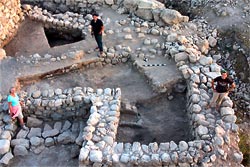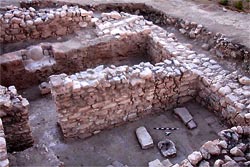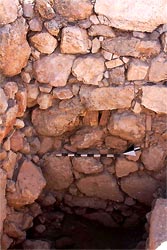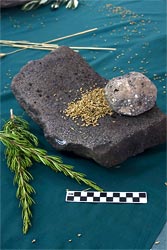Weekly Reports from Jordan
Choose Year: or Choose week
The Archaeological Results
Larry G. Herr and Douglas R. Clark
It's closedown week and heads are spinning with all sorts of frantic activities, from cleaning the last of the bones to picking up garbage around the camp; from desperately trying to reach the bottom of that wall to cleaning the muddy pottery pails; from fixing the last of the broken sifts to drawing the final top plans.
This report is going to be about the archaeological discoveries made during the course of the excavations. Huge thanks to Merlè Otto-Steenbergen for writing the weekly reports, giving insights about aspects of the dig we directors never would have thought of. But for those die-hard archaeologists who want to know what we found, this report will go through the finds field by field.
 In Field A, supervisor Bob Bates has been excavating two principal periods, one well known so far at Umayri and the other very rare. Rare one first: in all previous seasons we have had potsherds dating to the middle of the Iron 2 period (Iron 2B) and last season Brenda Adams' team uncovered earth layers limited to that period. These were the first in situ finds from Iron 2B so far found at Umayri.
In Field A, supervisor Bob Bates has been excavating two principal periods, one well known so far at Umayri and the other very rare. Rare one first: in all previous seasons we have had potsherds dating to the middle of the Iron 2 period (Iron 2B) and last season Brenda Adams' team uncovered earth layers limited to that period. These were the first in situ finds from Iron 2B so far found at Umayri.
 This season, however, Anneliese Weiss, Kemi Adedokun, and Kasey Brandt uncovered two rooms with walls rising four to five courses high. Between the walls was a thick destruction layer containing large amounts pottery from the Iron 2B period. Obviously the remains of this house will not be destroyed, but will be preserved as part of the architectural legacy of our excavation for future visitors to see.
This season, however, Anneliese Weiss, Kemi Adedokun, and Kasey Brandt uncovered two rooms with walls rising four to five courses high. Between the walls was a thick destruction layer containing large amounts pottery from the Iron 2B period. Obviously the remains of this house will not be destroyed, but will be preserved as part of the architectural legacy of our excavation for future visitors to see.
 Unfortunately, the Iron 2 house sits directly above the eastern portion of the third house dating to the transitional period between the Late Bronze Age and the Iron Age (LB/Iron 1). It was this earlier house our excavations in Field A were attempting to uncover. The good news is that three other teams from Field A (Stephanie Brown, Jessica Logan, and Megan Channer; Steven Salcido, Audrey Shaffer, and Natasha Plantak; Aaron Davis, Teagen Johnson, and Christa Watson) all were able to discover significant parts of this house.
Unfortunately, the Iron 2 house sits directly above the eastern portion of the third house dating to the transitional period between the Late Bronze Age and the Iron Age (LB/Iron 1). It was this earlier house our excavations in Field A were attempting to uncover. The good news is that three other teams from Field A (Stephanie Brown, Jessica Logan, and Megan Channer; Steven Salcido, Audrey Shaffer, and Natasha Plantak; Aaron Davis, Teagen Johnson, and Christa Watson) all were able to discover significant parts of this house.
 The bad news is that the destruction debris was either so deep above the floors or contained so many large broken pots that they were not able to excavate more than a few corners of several rooms. The plan of the house is not yet known, but the copious remains under the destruction make it clear that it was a domestic dwelling. Wait till next season!
The bad news is that the destruction debris was either so deep above the floors or contained so many large broken pots that they were not able to excavate more than a few corners of several rooms. The plan of the house is not yet known, but the copious remains under the destruction make it clear that it was a domestic dwelling. Wait till next season!
The final team in Field A (Brenda Adams, Eli Te, and Faith Stevens) was supposed to excavate the passageway through what appeared to be a gateway into the LB/Iron 1 walled city. Unfortunately, their excellent work has confused the picture significantly and we may have to abandon the idea of a gate (sigh!). After removing a late Iron 2 wall, they promptly found another one that seems to date to the LB/Iron 1 period! Unhappily, it marches right across the passageway and under the wall we had hoped to be the southern wall of the gate complex (another sigh). Some honorable hypotheses must, sadly, be discarded.
 |
 |
 Great news! Field B supervisor Kent Bramlett announces that Field B is finished, over, kaput. The magnificent floor of the palace/temple or temple/palace was completely uncovered, as were all the corners of the building. One surprise was that, because the building was constructed on top of the Middle Bronze Age rampart, the northern portions of the floor had to be built up to allow the floor to be level. This was done with mud bricks. Most of our work was done in the entrance room where two teams (Lindsey Hill and Garrick Herr; Carolyn Waldron, Stephanie Herr, and Erich Huffaker) converged from the south and the north respectively toward a plastered altar or base for a standing stone found lying on the surface nearby. Such finds seem to suggest strongly that the room was connected with cultic activities as was the western room that contained the plastered niche. This means all three northern rooms of the building had some kind of cultic connection.
Great news! Field B supervisor Kent Bramlett announces that Field B is finished, over, kaput. The magnificent floor of the palace/temple or temple/palace was completely uncovered, as were all the corners of the building. One surprise was that, because the building was constructed on top of the Middle Bronze Age rampart, the northern portions of the floor had to be built up to allow the floor to be level. This was done with mud bricks. Most of our work was done in the entrance room where two teams (Lindsey Hill and Garrick Herr; Carolyn Waldron, Stephanie Herr, and Erich Huffaker) converged from the south and the north respectively toward a plastered altar or base for a standing stone found lying on the surface nearby. Such finds seem to suggest strongly that the room was connected with cultic activities as was the western room that contained the plastered niche. This means all three northern rooms of the building had some kind of cultic connection.
 |
 |
 Other news regarding the building: a team made up of Ellen Bedell and Danielle Huffaker uncovered the northwestern corner of the building which is curved and not sharply angled. They also removed any Iron 2 remains above the structure in that area. Another team (Bethany Reiswig, and Steve Huffaker) were able to prove that the western part of the building was constructed atop the ruins of an earlier Middle Bronze Age structure made of mud brick. When they finished this operation, the same team (with the addition of Jim Fisher) moved to the east of Field B, opening a brand new field, Field N, and excavated the square immediately to the east of the building's doorway. They moved a record amount of over 30 cubic meters of debris to get to the entrance level just outside the building, enabling, once the intervening balk was removed, a dramatic view through the entrance of the building to the first room and its plastered base/altar. It also showed the dramatic nature of the earthquake which destroyed the building with the walls toppled to the east. Indeed, one large stone was shattered into two pieces and displaced almost a meter apart. Gary Huffaker and Kari Friestad were able to remove the Iron 2 wall above the southeastern corner of the structure and expose that part of the building.
Other news regarding the building: a team made up of Ellen Bedell and Danielle Huffaker uncovered the northwestern corner of the building which is curved and not sharply angled. They also removed any Iron 2 remains above the structure in that area. Another team (Bethany Reiswig, and Steve Huffaker) were able to prove that the western part of the building was constructed atop the ruins of an earlier Middle Bronze Age structure made of mud brick. When they finished this operation, the same team (with the addition of Jim Fisher) moved to the east of Field B, opening a brand new field, Field N, and excavated the square immediately to the east of the building's doorway. They moved a record amount of over 30 cubic meters of debris to get to the entrance level just outside the building, enabling, once the intervening balk was removed, a dramatic view through the entrance of the building to the first room and its plastered base/altar. It also showed the dramatic nature of the earthquake which destroyed the building with the walls toppled to the east. Indeed, one large stone was shattered into two pieces and displaced almost a meter apart. Gary Huffaker and Kari Friestad were able to remove the Iron 2 wall above the southeastern corner of the structure and expose that part of the building.
With walls standing over 2.5 meters high, this is one of the most dramatic Late Bronze Age buildings in the entire Holy Land and will be an influential addition to any study of the period. Plans are also afoot for Rhonda Root to produce a painting of the structure (similar to the oft-reproduced painting she did of the four-room house).
 If one were to look at Field H at the end of this season, one would not see very much. There are several flat earth layers stretching across wide expanses of the field, contained by a couple of walls and wall fragments. But supervisor Monique Vincent wears a broad smile as she looks at what her teams have accomplished and what lies ahead for next season. The entire field is now on the cusp of exposing a broad new area dating to the LB/Iron 1 transition, probably the most important period our site has so far produced.
If one were to look at Field H at the end of this season, one would not see very much. There are several flat earth layers stretching across wide expanses of the field, contained by a couple of walls and wall fragments. But supervisor Monique Vincent wears a broad smile as she looks at what her teams have accomplished and what lies ahead for next season. The entire field is now on the cusp of exposing a broad new area dating to the LB/Iron 1 transition, probably the most important period our site has so far produced.
 The team of Don Mook, Rob Saley, and Larry Murrin excavated three small rooms dating to the Iron 2 period, reached the bottom of three walls associated with these rooms, and removed the walls. In the process they excavated the top of a major destruction layer dating to the LB/Iron 1 period. Some of the walls from this period are just beginning to appear. Two other teams (Jeanne DelColle, Stefanie Elkins, and Kaitlyn Kramer; Julie Cormack, Bethany Melendy, and Talea Anderson) excavated a cobble floor and descended to the LB/Iron 1 destruction layer. They are ready for some great discoveries next season.
The team of Don Mook, Rob Saley, and Larry Murrin excavated three small rooms dating to the Iron 2 period, reached the bottom of three walls associated with these rooms, and removed the walls. In the process they excavated the top of a major destruction layer dating to the LB/Iron 1 period. Some of the walls from this period are just beginning to appear. Two other teams (Jeanne DelColle, Stefanie Elkins, and Kaitlyn Kramer; Julie Cormack, Bethany Melendy, and Talea Anderson) excavated a cobble floor and descended to the LB/Iron 1 destruction layer. They are ready for some great discoveries next season.
 Another team (Ivan LaBianca, Alice Holinger, and Jennifer Bernhardt) was charged with finding the bottom of the probable perimeter wall of the southwestern part of the site and its connection with what seemed to be a gate structure. Though they worked gallantly all season long and the wall is approximately nine courses high (each course is ca. 0.5 meters high), the wall is still descending.
Another team (Ivan LaBianca, Alice Holinger, and Jennifer Bernhardt) was charged with finding the bottom of the probable perimeter wall of the southwestern part of the site and its connection with what seemed to be a gate structure. Though they worked gallantly all season long and the wall is approximately nine courses high (each course is ca. 0.5 meters high), the wall is still descending.  However, they do seem to have reached the bottom of the possible gate structure (but see the conclusions regarding Brenda Adams' square in Field A above). One interesting realization is that the very deep perimeter wall in this square is in perfect alignment with the major wall in Brenda's square that blocks what we had thought was the gate passageway.
However, they do seem to have reached the bottom of the possible gate structure (but see the conclusions regarding Brenda Adams' square in Field A above). One interesting realization is that the very deep perimeter wall in this square is in perfect alignment with the major wall in Brenda's square that blocks what we had thought was the gate passageway.

 Our other new field, Field M (supervised by Aren LaBianca) promptly discovered a series of walls dating to the Persian period. The walls seem to correspond roughly with those found at the top of the Ammonite administrative center in Fields A and H. The purpose of this field is ultimately to begin the process of connecting Fields H and L (and the southern part of Field A) where we have discovered large Iron 1 walls made of huge boulders, some over two meters long. In one square Lizzie Brown, Elinor Matthews, and Jenna Hurtubise uncovered a complex series of walls and bins, making it appear that this was a domestic area.
Our other new field, Field M (supervised by Aren LaBianca) promptly discovered a series of walls dating to the Persian period. The walls seem to correspond roughly with those found at the top of the Ammonite administrative center in Fields A and H. The purpose of this field is ultimately to begin the process of connecting Fields H and L (and the southern part of Field A) where we have discovered large Iron 1 walls made of huge boulders, some over two meters long. In one square Lizzie Brown, Elinor Matthews, and Jenna Hurtubise uncovered a complex series of walls and bins, making it appear that this was a domestic area.
 A second team (Sean Haskell, Dana Waters, and Lynn Fulton) discovered similar walls and some hints of a floor. The skeletal remains of a 35-year-old male, buried against one of these walls, facing south toward Mecca were excavated, studied onsite, and then reburied elsewhere on the top of `Umayri by our workers from the nearby village of Bunayat.
A second team (Sean Haskell, Dana Waters, and Lynn Fulton) discovered similar walls and some hints of a floor. The skeletal remains of a 35-year-old male, buried against one of these walls, facing south toward Mecca were excavated, studied onsite, and then reburied elsewhere on the top of `Umayri by our workers from the nearby village of Bunayat.
To the east of this square there seems to have been a cobbled courtyard and not much else. The team of Autumn Whiteway, Merlè Otto-Steenbergen, and Jennifer Ayles excavated a prodigious amount of pottery, but a cobble/plaster surface was their result. No walls. Interestingly, by the end of the season they were discovering Iron 2B pottery. The late Iron 2/Persian period seems to be quite shallow in this area. Another team (Lloyd Willis, Jimmy Arsenault, and Evie Laurie) uncovered part of the same cobbled floor, but have a few wall fragments, as well.
 Field L co-field supervisors David Hopkins and Mary Boyd enjoyed the presence of David's students from Wesley Theological Seminary in Washington, DC during the second half of the season. They had four operations going. Ruth Kent and Rebecca Richards excavated a large, very well preserved tabun (clay oven), as well as the late Iron 2 surface associated with it. Standing to a height of some 40 cm above the associated floor, the tabun may have been complete. Earlier in the season, Ruth Kent and Slava Bouz had discovered a later plaster-and-cobble surface also dated to the late Iron 2 period.
Field L co-field supervisors David Hopkins and Mary Boyd enjoyed the presence of David's students from Wesley Theological Seminary in Washington, DC during the second half of the season. They had four operations going. Ruth Kent and Rebecca Richards excavated a large, very well preserved tabun (clay oven), as well as the late Iron 2 surface associated with it. Standing to a height of some 40 cm above the associated floor, the tabun may have been complete. Earlier in the season, Ruth Kent and Slava Bouz had discovered a later plaster-and-cobble surface also dated to the late Iron 2 period.
 For two days Mary Boyd continued an earlier probe to discover the bottom of a large wall we suspected was Iron 1. Indeed, the bottom of the wall was discovered and its founding level was Iron 1.
For two days Mary Boyd continued an earlier probe to discover the bottom of a large wall we suspected was Iron 1. Indeed, the bottom of the wall was discovered and its founding level was Iron 1.
Most of the Wesley students worked on two new squares to the west of the field, part of our attempt to connect Fields L and H through Field M. Although we had thought they would have to proceed through large rock tumble, they encountered significant walls from the late Iron 2 period almost immediately under the ground surface. They have not yet reached any surfaces so we cannot understand the function of the rooms.
 Ela Dubis came back this season with a small team from Krakow, Poland (Marzena Daszewska, her mother Ewa Dazsewska, and Remigiusz Wilk, and his mother Grazyna Swoboda-Wilk) to draw and excavate a couple of balks near the Field K dolmen on the lower southeastern slope of the site. In several earlier seasons Ela's team had discovered a dolmen with the first significantly preserved remains in the entire Mediterranean basin. Even more, they had found a series of surfaces around the dolmen showing that the site was a center of ceremonial activities for several hundred years.
Ela Dubis came back this season with a small team from Krakow, Poland (Marzena Daszewska, her mother Ewa Dazsewska, and Remigiusz Wilk, and his mother Grazyna Swoboda-Wilk) to draw and excavate a couple of balks near the Field K dolmen on the lower southeastern slope of the site. In several earlier seasons Ela's team had discovered a dolmen with the first significantly preserved remains in the entire Mediterranean basin. Even more, they had found a series of surfaces around the dolmen showing that the site was a center of ceremonial activities for several hundred years.
 However, no walls had been found. This season, while a balk was being dismantled, a wall appeared with three short wall fragments extending from it, suggesting that there was a shelter associated with the ceremonial activities. The shelter was very near a stone "table" preserved in one of the surfaces. This find heightens the sense of importance attached to the site, as there exists extremely little or no evidence anywhere else of surrounding surfaces or structures associated with dolmens.
However, no walls had been found. This season, while a balk was being dismantled, a wall appeared with three short wall fragments extending from it, suggesting that there was a shelter associated with the ceremonial activities. The shelter was very near a stone "table" preserved in one of the surfaces. This find heightens the sense of importance attached to the site, as there exists extremely little or no evidence anywhere else of surrounding surfaces or structures associated with dolmens.
As all of these finds prove, it certainly was a successful season. Moreover, it shows that much more will be found in the future. Long live Tall al-`Umayri!
Check out these artifactual finds:
 |
 |
 |
|
 |
 |
 |
|
 |
 |
 |
 |
 |
 |
[Photos courtesy of Douglas R. Clark and MPP-`Umayri]